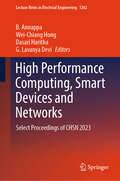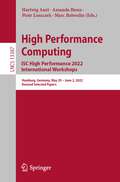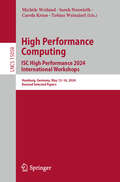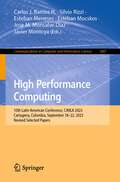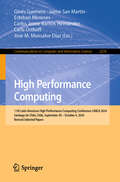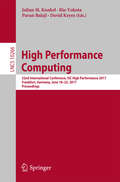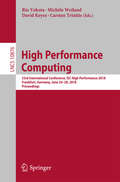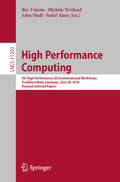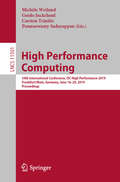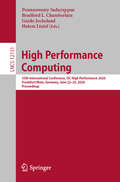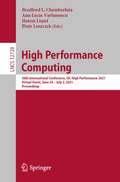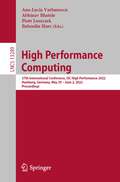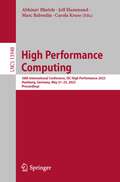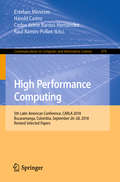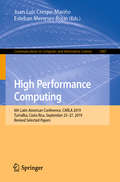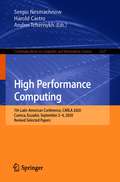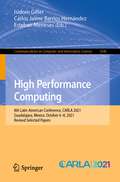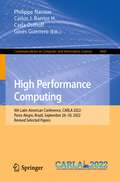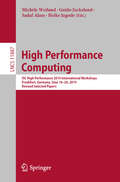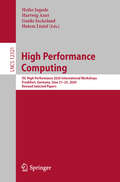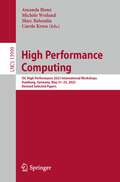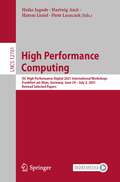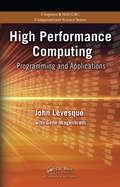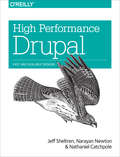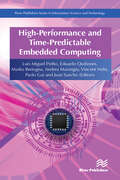- Table View
- List View
High Performance Computing, Smart Devices and Networks: Select Proceedings of CHSN 2023 (Lecture Notes in Electrical Engineering #1262)
by Wei-Chiang Hong G. Lavanya Devi B. Annappa Dasari HarithaThis book comprises the proceedings of the 4th International Conference on Computer Vision, High-Performance Computing, Smart Devices, and Networks (CHSN 2023). This book highlights high-quality research articles in machine learning, computer vision, and networks. The content of this volume gives the reader an up-to-date picture of the state-of-the-art connection between computational intelligence, machine learning, and IoT. The papers in this volume are peer-reviewed by experts in related areas. The book serves as a valuable reference resource for academics and researchers across the globe.
High Performance Computing. ISC High Performance 2022 International Workshops: Hamburg, Germany, May 29 – June 2, 2022, Revised Selected Papers (Lecture Notes in Computer Science #13387)
by Hartwig Anzt Piotr Luszczek Amanda Bienz Marc BaboulinThis book constitutes the refereed conference proceedings of the workshops held at the 37th International ISC High Performance 2022 Conference, in Hamburg, Germany, in June 2, 2022.The 27 full papers were included in this book were carefully reviewed and selected from 43 submissions. ISC High Performance 2022 presents the following workshops:Compiler-assisted Correctness Checking and Performance Optimization for HPCHPC on Heterogeneous Hardware (H3)Malleability Techniques Applications in High Performance ComputingFifth Workshop on Interactive High Performance Computing3rd ISC HPC International Workshop on Monitoring & Operational Data Analytics6th International Workshop on In Situ Visualization17th Workshop on Virtualization in High Performance Cloud Computing
High Performance Computing. ISC High Performance 2024 International Workshops: Hamburg, Germany, May 12–16, 2024, Revised Selected Papers (Lecture Notes in Computer Science #15058)
by Tobias Weinzierl Michèle Weiland Carola Kruse Sarah NeuwirthThis book constitutes the refereed workshop proceedings from the 39th International conference on High Performance Computing, ISC High Performance 2024, held in Hamburg, Germany, in May 2024. The 34 full papers presented here were carefully reviewed and selected from 50 submissions. These proceedings include papers from the following workshops:- Compiler-Assisted Correctness Checking and Performance Optimization for HPC Workshop (C3PO 2024) HPC on Heterogeneous Hardware Workshop (H3 2024) Third Workshop on Communication, I/O, and Storage at Scale on Next-Generation Platforms – Scalable Infrastructures (ISC 2024 IXPUG) HPC I/O in the Data Center Workshop (HPC-IODC 2024) Third Combined Workshop on Interactive and Urgent Supercomputing (CW-IUS 2024) 5th ISC HPC International Workshop on Monitoring & Operational Data Analytics (MODA24) Fourth International Workshop on RISC-V for HPC 2nd International Workshop on Sustainable Supercomputing Second International Workshop on Converged Computing on Edge, Cloud, and HPC (WOCC’24) 8th International Workshop on In Situ Visualization (WOIV’24)
High Performance Computing: 10th Latin American Conference, CARLA 2023, Cartagena, Colombia, September 18–22, 2023, Revised Selected Papers (Communications in Computer and Information Science #1887)
by Esteban Mocskos Esteban Meneses Carlos J. Barrios H. Silvio Rizzi Jose M. Monsalve Diaz Javier MontoyaThis book constitutes the refereed revised selected papers of the 10th Latin American Conference on High Performance Computing, CARLA 2023, held in Cartagena, Colombia, during September 18–22, 2023.The 14 full papers included in this book were carefully reviewed and selected from 26 submissions. They were organized in topical sections as follows: High Performance Computing (HPC), Artificial Intelligence using HPC Scale and High Performance Computing Applications.
High Performance Computing: 11th Latin American High Performance Computing Conference, CARLA 2024, Santiago de Chile, Chile, September 30 – October 4, 2024, Revised Selected Papers (Communications in Computer and Information Science #2270)
by Carla Osthoff Carlos Jaime Barrios Hernández Esteban Meneses Jaime San Martín Ginés Guerrero Jose M. Monsalve DiazThis book constitutes the refereed revised selected papers of the 11th Latin American Conference on High Performance Computing, CARLA 2024, held in Santiago de Chile, Chile, during September 30–October 4, 2024. The 21 full papers included in this book were carefully reviewed and selected from 42 submissions. They were organized in topical sections as follows: High Performance Computing Track; Artificial Intelligence at HPC Scale Track; High Performance Computing Applications Track.
High Performance Computing: 32nd International Conference, ISC High Performance 2017, Frankfurt, Germany, June 18–22, 2017, Proceedings (Lecture Notes in Computer Science #10266)
by David Keyes Julian M. Kunkel Pavan Balaji Rio YokotaThis book constitutes revised selected papers from 7 workshops that were held in conjunction with the ISC High Performance 2016 conference in Frankfurt, Germany, in June 2016. The 45 papers presented in this volume were carefully reviewed and selected for inclusion in this book. They stem from the following workshops: Workshop on Exascale Multi/Many Core Computing Systems, E-MuCoCoS; Second International Workshop on Communication Architectures at Extreme Scale, ExaComm; HPC I/O in the Data Center Workshop, HPC-IODC; International Workshop on OpenPOWER for HPC, IWOPH; Workshop on the Application Performance on Intel Xeon Phi - Being Prepared for KNL and Beyond, IXPUG; Workshop on Performance and Scalability of Storage Systems, WOPSSS; and International Workshop on Performance Portable Programming Models for Accelerators, P3MA.
High Performance Computing: 33rd International Conference, ISC High Performance 2018, Frankfurt, Germany, June 24-28, 2018, Proceedings (Lecture Notes in Computer Science #10876)
by David Keyes Rio Yokota Michèle Weiland Carsten TrinitisThis book constitutes the refereed proceedings of the 33rd International Conference, ISC High Performance 2018, held in Frankfurt, Germany, in June 2018. The 20 revised full papers presented in this book were carefully reviewed and selected from 81 submissions. The papers cover the following topics: Resource Management and Energy Efficiency; Performance Analysis and Tools; Exascale Networks; Parallel Algorithms.
High Performance Computing: 33rd International Conference, Isc High Performance 2018, Frankfurt, Germany, June 24-28, 2018, Proceedings (Lecture Notes in Computer Science #10876)
by Rio Yokota John Shalf Michèle Weiland Sadaf AlamThis book constitutes the refereed proceedings of the 33rd International Conference, ISC High Performance 2018, held in Frankfurt, Germany, in June 2018. The 20 revised full papers presented in this book were carefully reviewed and selected from 81 submissions. The papers cover the following topics: Resource Management and Energy Efficiency; Performance Analysis and Tools; Exascale Networks; Parallel Algorithms.
High Performance Computing: 34th International Conference, ISC High Performance 2019, Frankfurt/Main, Germany, June 16–20, 2019, Proceedings (Lecture Notes in Computer Science #11501)
by Guido Juckeland Michèle Weiland Carsten Trinitis Ponnuswamy SadayappanThis book constitutes the refereed proceedings of the 34th International Conference on High Performance Computing, ISC High Performance 2019, held in Frankfurt/Main, Germany, in June 2019.The 17 revised full papers presented were carefully reviewed and selected from 70 submissions. The papers cover a broad range of topics such as next-generation high performance components; exascale systems; extreme-scale applications; HPC and advanced environmental engineering projects; parallel ray tracing - visualization at its best; blockchain technology and cryptocurrency; parallel processing in life science; quantum computers/computing; what's new with cloud computing for HPC; parallel programming models for extreme-scale computing; workflow management; machine learning and big data analytics; and deep learning and HPC.
High Performance Computing: 35th International Conference, ISC High Performance 2020, Frankfurt/Main, Germany, June 22–25, 2020, Proceedings (Lecture Notes in Computer Science #12151)
by Guido Juckeland Ponnuswamy Sadayappan Bradford L. Chamberlain Hatem LtaiefThis book constitutes the refereed proceedings of the 35th International Conference on High Performance Computing, ISC High Performance 2020, held in Frankfurt/Main, Germany, in June 2020.*The 27 revised full papers presented were carefully reviewed and selected from 87 submissions. The papers cover a broad range of topics such as architectures, networks & infrastructure; artificial intelligence and machine learning; data, storage & visualization; emerging technologies; HPC algorithms; HPC applications; performance modeling & measurement; programming models & systems software. *The conference was held virtually due to the COVID-19 pandemic.Chapters "Scalable Hierarchical Aggregation and Reduction Protocol (SHARP) Streaming-Aggregation Hardware Design and Evaluation", "Solving Acoustic Boundary Integral Equations Using High Performance Tile Low-Rank LU Factorization", "Scaling Genomics Data Processing with Memory-Driven Computing to Accelerate Computational Biology", "Footprint-Aware Power Capping for Hybrid Memory Based Systems", and "Pattern-Aware Staging for Hybrid Memory Systems" are available open access under a Creative Commons Attribution 4.0 International License via link.springer.com.
High Performance Computing: 36th International Conference, ISC High Performance 2021, Virtual Event, June 24 – July 2, 2021, Proceedings (Lecture Notes in Computer Science #12728)
by Bradford L. Chamberlain Hatem Ltaief Ana-Lucia Varbanescu Piotr LuszczekThis book constitutes the refereed proceedings of the 36th International Conference on High Performance Computing, ISC High Performance 2021, held virtually in June/July 2021.The 24 full papers presented were carefully reviewed and selected from 74 submissions. The papers cover a broad range of topics such as architecture, networks, and storage; machine learning, AI, and emerging technologies; HPC algorithms and applications; performance modeling, evaluation, and analysis; and programming environments and systems software.
High Performance Computing: 37th International Conference, ISC High Performance 2022, Hamburg, Germany, May 29 – June 2, 2022, Proceedings (Lecture Notes in Computer Science #13289)
by Abhinav Bhatele Ana-Lucia Varbanescu Piotr Luszczek Baboulin MarcThis book constitutes the refereed proceedings of the 37th International Conference on High Performance Computing, ISC High Performance 2022, held in Hamburg, Germany, during May 29 – June 2, 2022. The 18 full papers presented were carefully reviewed and selected from 53 submissions. The papers are categorized into the following topical sub-headings: Architecture, Networks, and Storage; Machine Learning, AI, Emerging Technologies; HPC Algorithms and Applications; Performance Modeling, Evaluation and Analysis; and Programming Environments and Systems Software.
High Performance Computing: 38th International Conference, ISC High Performance 2023, Hamburg, Germany, May 21–25, 2023, Proceedings (Lecture Notes in Computer Science #13948)
by Abhinav Bhatele Jeff Hammond Marc Baboulin Carola KruseThis book constitutes the proceedings of the 38th International Conference on High Performance Computing, ISC High Performance 2023, which took place in Hamburg, Germany, in May 2023. The 21 papers presented in this volume were carefully reviewed and selected from 78 submissions. They were organized in topical sections as follows: Architecture, Networks, and Storage; HPC Algorithms & Applications; Machine Learning, AI, & Quantum Computing; Performance Modeling, Evaluation, & Analysis; and Programming Environments & Systems Software.
High Performance Computing: 5th Latin American Conference, CARLA 2018, Bucaramanga, Colombia, September 26–28, 2018, Revised Selected Papers (Communications in Computer and Information Science #979)
by Carlos Jaime Barrios Hernández Esteban Meneses Harold Castro Raul Ramos-PollanThis book constitutes the proceedings of the 5th Latin American Conference, CARLA 2018, held in Bucaramanga, Colombia, in September 2018.The 24 papers presented in this volume were carefully reviewed and selected from 38 submissions. They are organized in topical sections on: Artificial Intelligence; Accelerators; Applications; Performance Evaluation; Platforms and Infrastructures; Cloud Computing.
High Performance Computing: 6th Latin American Conference, CARLA 2019, Turrialba, Costa Rica, September 25–27, 2019, Revised Selected Papers (Communications in Computer and Information Science #1087)
by Juan Luis Crespo-Mariño Esteban Meneses-RojasThis book constitutes the refereed proceedings of the 6th Latin American High Performance Computing Conference, CARLA 2019, held in Turrialba, Costa Rica, in September 2019. The 32 revised full papers presented were carefully reviewed and selected out of 62 submissions. The papers included in this book are organized according to the conference tracks - regular track on high performance computing: applications; algorithms and models; architectures and infrastructures; and special track on bioinspired processing (BIP): neural and evolutionary approaches; image and signal processing; biodiversity informatics and computational biology.
High Performance Computing: 7th Latin American Conference, CARLA 2020, Cuenca, Ecuador, September 2–4, 2020, Revised Selected Papers (Communications in Computer and Information Science #1327)
by Sergio Nesmachnow Andrei Tchernykh Harold CastroThis book constitutes revised selected papers of the 7th Latin American High Performance Computing Conference, CARLA 2020, held in Cuenca, Ecuador, in September 2020. Due to the COVID-19 pandemic the conference was held in a virtual mode. The 15 revised full papers presented were carefully reviewed and selected out of 36 submissions. The papers included in this book are organized according to the topics on High Performance Computing Applications; High Performance Computing and Artificial Intelligence.
High Performance Computing: 8th Latin American Conference, CARLA 2021, Guadalajara, Mexico, October 6–8, 2021, Revised Selected Papers (Communications in Computer and Information Science #1540)
by Isidoro Gitler Carlos Jaime Barrios Hernández Esteban MenesesThis book constitutes revised selected papers of the 8th Latin American High Performance Computing Conference, CARLA 2021, held in Guadalajara, Mexico, in October 2021. Due to the COVID-19 pandemic the conference was held in a virtual mode. The 16 revised full papers and 2 short papers presented were carefully reviewed and selected out of 45 submissions. The papers included in this book are organized according to the topics on high performance computing; high performance computing and artificial intelligence; high performance computing applications.
High Performance Computing: 9th Latin American Conference, CARLA 2022, Porto Alegre, Brazil, September 26–30, 2022, Revised Selected Papers (Communications in Computer and Information Science #1660)
by Carla Osthoff Philippe Navaux Carlos J. Barrios H. Ginés GuerreroThis book constitutes the proceedings of the 9th Latin American Conference on High Performance Computing, CARLA 2022, held in Porto Alegre, Brazil, in September 2022. The 16 full papers presented in this volume were carefully reviewed and selected from 56 submissions.CARLA, the Latin American High Performance Computing Conference, is an international academic meeting aimed at providing a forum to foster the growth and strength of the High Performance Computing (HPC) community in Latin America and the Caribbean through the exchange and dissemination of new ideas, techniques, and research in HPC and its application areas.
High Performance Computing: ISC High Performance 2019 International Workshops, Frankfurt, Germany, June 16-20, 2019, Revised Selected Papers (Lecture Notes in Computer Science #11887)
by Guido Juckeland Michèle Weiland Sadaf Alam Heike JagodeThis book constitutes the refereed post-conference proceedings of 13 workshops held at the 34th International ISC High Performance 2019 Conference, in Frankfurt, Germany, in June 2019: HPC I/O in the Data Center (HPC-IODC), Workshop on Performance & Scalability of Storage Systems (WOPSSS), Workshop on Performance & Scalability of Storage Systems (WOPSSS), 13th Workshop on Virtualization in High-Performance Cloud Computing (VHPC '18), 3rd International Workshop on In Situ Visualization: Introduction and Applications, ExaComm: Fourth International Workshop on Communication Architectures for HPC, Big Data, Deep Learning and Clouds at Extreme Scale, International Workshop on OpenPOWER for HPC (IWOPH18), IXPUG Workshop: Many-core Computing on Intel, Processors: Applications, Performance and Best-Practice Solutions, Workshop on Sustainable Ultrascale Computing Systems, Approximate and Transprecision Computing on Emerging Technologies (ATCET), First Workshop on the Convergence of Large Scale Simulation and Artificial Intelligence, 3rd Workshop for Open Source Supercomputing (OpenSuCo), First Workshop on Interactive High-Performance Computing, Workshop on Performance Portable Programming Models for Accelerators (P^3MA). The 48 full papers included in this volume were carefully reviewed and selected. They cover all aspects of research, development, and application of large-scale, high performance experimental and commercial systems. Topics include HPC computer architecture and hardware; programming models, system software, and applications; solutions for heterogeneity, reliability, power efficiency of systems; virtualization and containerized environments; big data and cloud computing; and artificial intelligence.
High Performance Computing: ISC High Performance 2020 International Workshops, Frankfurt, Germany, June 21–25, 2020, Revised Selected Papers (Lecture Notes in Computer Science #12321)
by Guido Juckeland Heike Jagode Hatem Ltaief Hartwig AnztThis book constitutes the refereed post-conference proceedings of 10 workshops held at the 35th International ISC High Performance 2020 Conference, in Frankfurt, Germany, in June 2020: First Workshop on Compiler-assisted Correctness Checking and Performance Optimization for HPC (C3PO); First International Workshop on the Application of Machine Learning Techniques to Computational Fluid Dynamics Simulations and Analysis (CFDML); HPC I/O in the Data Center Workshop (HPC-IODC); First Workshop \Machine Learning on HPC Systems" (MLHPCS); First International Workshop on Monitoring and Data Analytics (MODA); 15th Workshop on Virtualization in High-Performance Cloud Computing (VHPC). The 25 full papers included in this volume were carefully reviewed and selected. They cover all aspects of research, development, and application of large-scale, high performance experimental and commercial systems. Topics include high-performance computing (HPC), computer architecture and hardware, programming models, system software, performance analysis and modeling, compiler analysis and optimization techniques, software sustainability, scientific applications, deep learning.
High Performance Computing: ISC High Performance 2023 International Workshops, Hamburg, Germany, May 21–25, 2023, Revised Selected Papers (Lecture Notes in Computer Science #13999)
by Michèle Weiland Amanda Bienz Marc Baboulin Carola KruseThis volume constitutes the papers of several workshops which were held in conjunction with the 38th International Conference on High Performance Computing, ISC High Performance 2023, held in Hamburg, Germany, during May 21–25, 2023. The 49 revised full papers presented in this book were carefully reviewed and selected from 70 submissions. ISC High Performance 2023 presents the following workshops: 2nd International Workshop on Malleability Techniques Applications in High-Performance Computing (HPCMALL)18th Workshop on Virtualization in High-Performance Cloud Computing (VHPC 23)HPC I/O in the Data Center (HPC IODC)Workshop on Converged Computing of Cloud, HPC, and Edge (WOCC’23)7th International Workshop on In Situ Visualization (WOIV’23)Workshop on Monitoring and Operational Data Analytics (MODA23)2nd Workshop on Communication, I/O, and Storage at Scale on Next-Generation Platforms: Scalable InfrastructuresFirst International Workshop on RISC-V for HPCSecond Combined Workshop on Interactive and Urgent Supercomputing (CWIUS)HPC on Heterogeneous Hardware (H3)
High Performance Computing: ISC High Performance Digital 2021 International Workshops, Frankfurt am Main, Germany, June 24 – July 2, 2021, Revised Selected Papers (Lecture Notes in Computer Science #12761)
by Heike Jagode Hatem Ltaief Hartwig Anzt Piotr LuszczekThis book constitutes the refereed post-conference proceedings of 9 workshops held at the 35th International ISC High Performance 2021 Conference, in Frankfurt, Germany, in June-July 2021:Second International Workshop on the Application of Machine Learning Techniques to Computational Fluid Dynamics and Solid Mechanics Simulations and Analysis; HPC-IODC: HPC I/O in the Data Center Workshop; Compiler-assisted Correctness Checking and Performance Optimization for HPC; Machine Learning on HPC Systems;4th International Workshop on Interoperability of Supercomputing and Cloud Technologies;2nd International Workshop on Monitoring and Operational Data Analytics;16th Workshop on Virtualization in High-Performance Cloud Computing; Deep Learning on Supercomputers; 5th International Workshop on In Situ Visualization. The 35 papers included in this volume were carefully reviewed and selected. They cover all aspects of research, development, and application of large-scale, high performance experimental and commercial systems. Topics include high-performance computing (HPC), computer architecture and hardware, programming models, system software, performance analysis and modeling, compiler analysis and optimization techniques, software sustainability, scientific applications, deep learning.
High Performance Computing: Programming and Applications (Chapman & Hall/CRC Computational Science)
by John Levesque Gene WagenbrethHigh Performance Computing: Programming and Applications presents techniques that address new performance issues in the programming of high performance computing (HPC) applications. Omitting tedious details, the book discusses hardware architecture concepts and programming techniques that are the most pertinent to application developers for achievi
High Performance Drupal: Fast and Scalable Designs
by Nathaniel Catchpole Jeff Sheltren Narayan NewtonHow can you help your Drupal website continue to perform at the highest level as it grows to meet demand? This comprehensive guide provides best practices, examples, and in-depth explanations for solving several performance and scalability issues. You’ll learn how to apply coding and infrastructure techniques to Drupal internals, application performance, databases, web servers, and performance analysis.Covering Drupal versions 7 and 8, this book is the ideal reference for everything from site deployment to implementing specific technologies such as Varnish, memcache, or Solr. If you have a basic understanding of Drupal and the Linux-Apache-MySQL-PHP (LAMP) stack, you’re ready to get started.Establish a performance baseline and define goals for improvementOptimize your website’s code and front-end performanceGet best and worst practices for customizing Drupal core functionalityApply infrastructure design techniques to launch or expand a siteUse tools to configure, monitor, and optimize MySQL performanceEmploy alternative storage and backend search options as your site growsTune your web servers through httpd and PHP configurationMonitor services and perform load tests to catch problems before they become critical
High Performance Embedded Computing
by Marko Bertogna Eduardo Quiñones Luís Miguel Pinho Andrea Marongiu Vincent Nélis Paolo Gai Juan SanchoNowadays, the prevalence of computing systems in our lives is so ubiquitous that we live in a cyber-physical world dominated by computer systems, from pacemakers to cars and airplanes. These systems demand for more computational performance to process large amounts of data from multiple data sources with guaranteed processing times. Actuating outside of the required timing bounds may cause the failure of the system, being vital for systems like planes, cars, business monitoring, e-trading, etc. High-Performance and Time-Predictable Embedded Computing presents recent advances in software architecture and tools to support such complex systems, enabling the design of embedded computing devices which are able to deliver high-performance whilst guaranteeing the application required timing bounds. Technical topics discussed in the book include: Parallel embedded platforms Programming models Mapping and scheduling of parallel computations Timing and schedulability analysis Runtimes and operating systemsThe work reflected in this book was done in the scope of the European project P SOCRATES, funded under the FP7 framework program of the European Commission. High-performance and time-predictable embedded computing is ideal for personnel in computer/communication/embedded industries as well as academic staff and master/research students in computer science, embedded systems, cyber-physical systems and internet-of-things.
